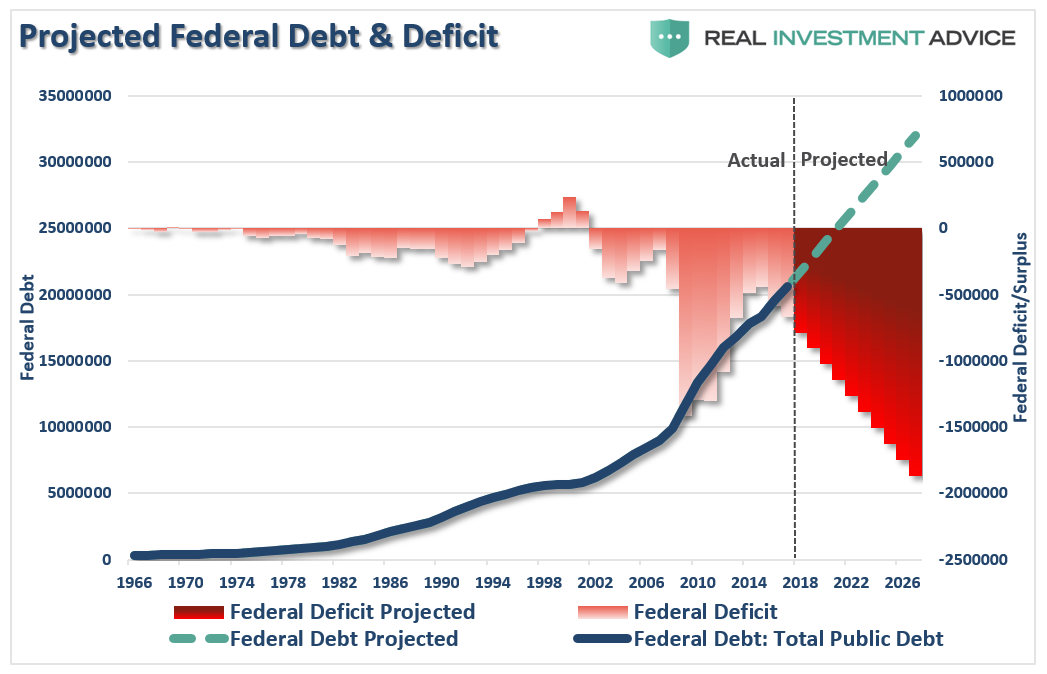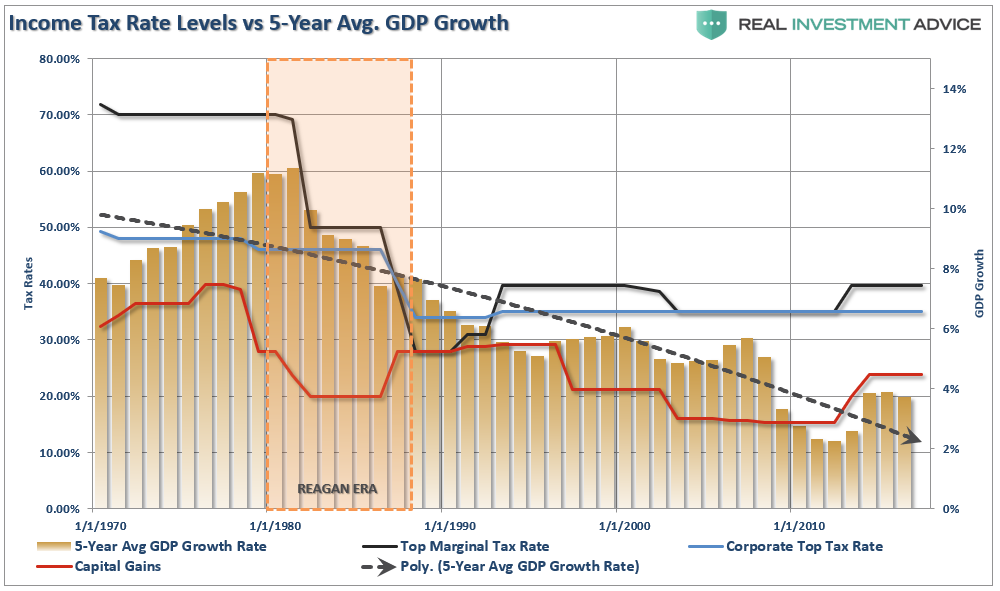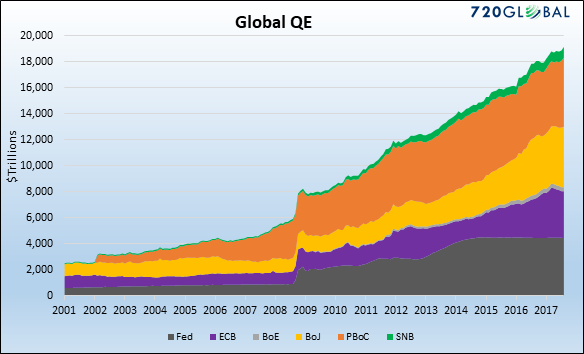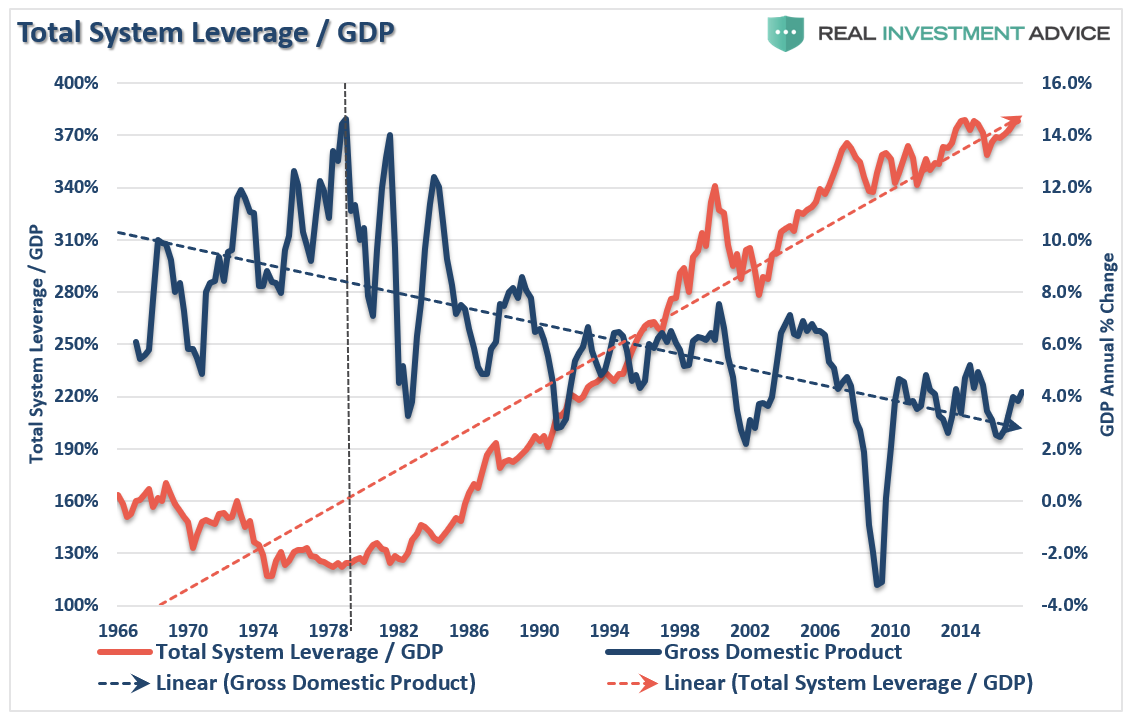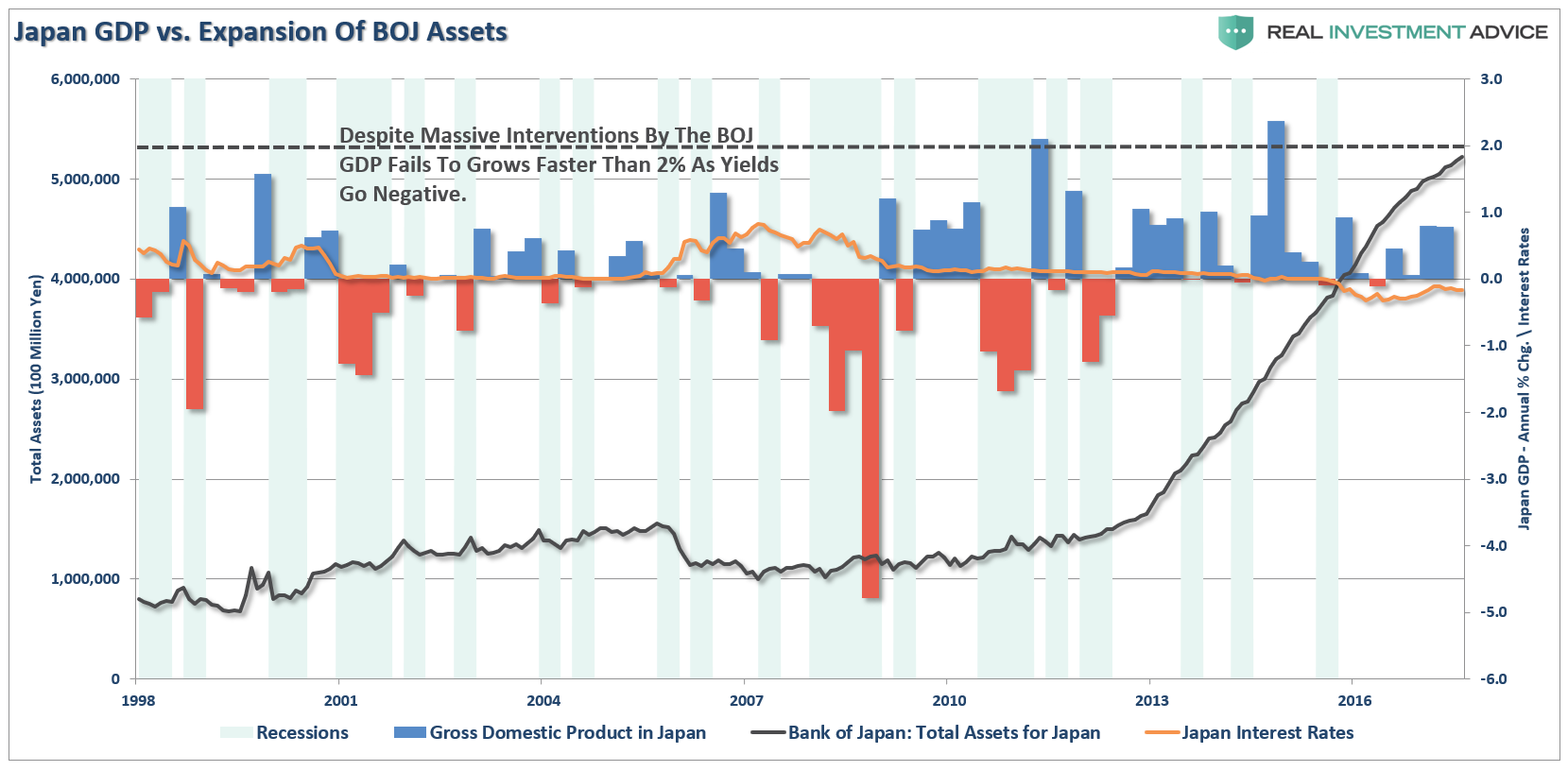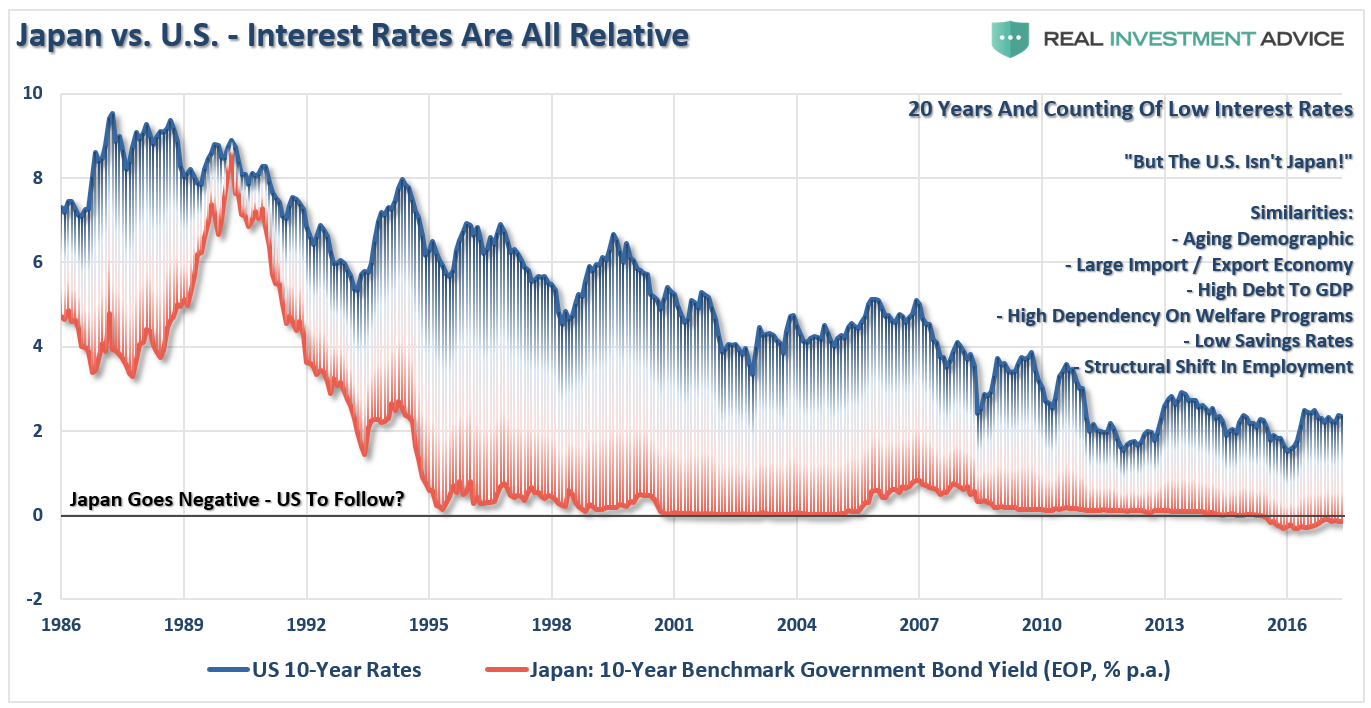On Friday, Kevin Brady of the House Ways and Means Committee was on my radio program discussing the “Tax Cuts & Jobs Act” bill which was released later in the day.
Here are the details of the release he referenced in the interview.
Of course, the real question is how are you going to “pay for it?”
Even as Kevin Brady noted in our interview, when I discussed the “fiscal” side of the tax reform bill, without achieving accelerated rates of economic growth – “the debt will balloon.”
The reality, of course, is that is exactly what will happen because there is absolutely NO historical evidence that cutting taxes, without offsetting cuts to spending, leads to stronger economic growth.
Those, of course, are the long-term concerns that will lead to lower rates of returns for equity-based investors and will continue to suppress interest rates for the next decade as the “Japanification” of the U.S. continues.
Let’s Be Like Japan
“Bad debt is the root of the crisis. Fiscal stimulus may help economies for a couple of years but once the ‘painkilling’ effect wears off, U.S. and European economies will plunge back into crisis. The crisis won’t be over until the nonperforming assets are off the balance sheets of US and European banks.” – Keiichiro Kobayashi, 2010
While Kobayashi will ultimately be right, what he never envisioned was the extent to which Central Banks globally would be willing to go. As my partner Michael Lebowitz pointed out last week:
“Global central banks’ post-financial crisis monetary policies have collectively been more aggressive than anything witnessed in modern financial history. Over the last ten years, the six largest central banks have printed unprecedented amounts of money to purchase approximately $14 trillion of financial assets as shown below. Before the financial crisis of 2008, the only central bank printing money of any consequence was the Peoples Bank of China (PBoC).”
As he noted, the belief was that by driving asset prices higher, economic growth would follow. Unfortunately, this has yet to be the case as debt both globally and specifically in the U.S. has exploded.
“QE has forced interest rates downward and lowered interest expenses for all debtors. Simultaneously, it boosted the amount of outstanding debt. The net effect is that the global debt burden has grown on a nominal basis and as a percentage of economic growth since 2008. The debt burden has become even more burdensome.”
While Mr. Brady is very optimistic about future rates of economic growth, even Ms. Yellen in her latest policy announcement was not so sure. The Fed’s average of long-term growth expectations is currently running at just 1.9%.
The continuing mounting of debt from both the public and private sector, combined with rising health care costs, particularly for aging “baby boomers,” are among the factors behind soaring US debt. While “tax reform,” in a “vacuum” should boost rates of consumption and, ultimately, economic growth, the economic drag of poor demographics and soaring costs, will offset any of the benefits.
The complexity of the current environment implies years of sub-par economic growth ahead as noted by the Fed last week. Of course, the US is not the only country facing such a gloomy outlook for public finances, but the current economic overlay displays compelling similarities with Japan in the 1990s.
Also, while it is believed that “tax reform” will fix the problem of lackluster wage growth, create more jobs, and boost economic prosperity, one should at least question the logic given that more expansive spending, as represented in the chart above by the surge in debt, is having no substantial impact on economic growth. As I have written previously, debt is a retardant to organic economic growth as it diverts dollars from productive investment to debt service.
Of course, one only needs to look at Japan for an understanding that QE, low-interest rate policies and expansion of debt have done little economically. Take a look at the chart below which shows the expansion of the BOJ assets versus growth of GDP and levels of interest rates.
Notice that since 1998, Japan has not achieved a 2% rate of economic growth. Even with interest rates now pushing into negative territory, economic growth remains mired below one-percent, providing little evidence to support the idea that inflating asset prices by buying assets leads to stronger economic outcomes.
But yet, the current Administration believes our outcome will be different.
The reality is that the U.S. is now caught in the same liquidity trap as Japan. With the current economic recovery already pushing the long end of the economic cycle, the risk is rising that the next economic downturn is closer than not. The danger is that the Federal Reserve is now potentially trapped with an inability to use monetary policy tools to offset the next economic decline when it occurs.
This is the same problem that Japan has wrestled with for the last 20 years. While Japan has entered into an unprecedented stimulus program (on a relative basis twice as large as the U.S. on an economy 1/3 the size) there is no guarantee that such a program will result in the desired effect of pulling the Japanese economy out of its 30-year deflationary cycle. The problems that face Japan are similar to what we are currently witnessing in the U.S.:
- A decline in savings rates to extremely low levels which depletes productive investments
- An aging demographic that is top heavy and drawing on social benefits at an advancing rate.
- A heavily indebted economy with debt/GDP ratios above 100%.
- A decline in exports due to a weak global economic environment.
- Slowing domestic economic growth rates.
- An underemployed younger demographic.
- An inelastic supply-demand curve
- Weak industrial production
- Dependence on productivity increases to offset reduced employment
The lynchpin to Japan, and the U.S., remains demographics and interest rates. As the aging population grows becoming a net drag on “savings,” the dependency on the “social welfare net” will continue to expand. The “pension problem” is only the tip of the iceberg.
If interest rates rise sharply it is effectively “game over” as borrowing costs surge, deficits balloon, housing falls, revenues weaken and consumer demand wanes. It is the worst thing that can happen to an economy that is currently remaining on life support.
Japan, like the U.S., is caught in an on-going “liquidity trap” where maintaining ultra-low interest rates are the key to sustaining an economic pulse. The unintended consequence of such actions, as we are witnessing in the U.S. currently, is the ongoing battle with deflationary pressures. The lower interest rates go – the less economic return that can be generated. An ultra-low interest rate environment, contrary to mainstream thought, has a negative impact on making productive investments and risk begins to outweigh the potential return.
More importantly, while there are many calling for an end of the “Great Bond Bull Market,” this is unlikely the case. As shown in the chart below, interest rates are relative globally. Rates can’t rise in one country while a majority of economies are pushing negative rates. As has been the case over the last 30-years, so goes Japan, so goes the U.S.
Unfortunately, for the Administration, the reality is that cutting taxes, and MORE debt, is unlikely to change the outcome in the U.S. The reason is that monetary interventions and government spending don’t create organic, and sustainable, economic growth. Simply pulling forward future consumption through monetary policy continues to leave an ever-growing void in the future that must be filled. Eventually, the void will be too great to fill.
But hey, let’s just keep doing the same thing over and over again, which hasn’t worked for anyone as of yet, hoping for a different result.
What’s the worst that could happen?

